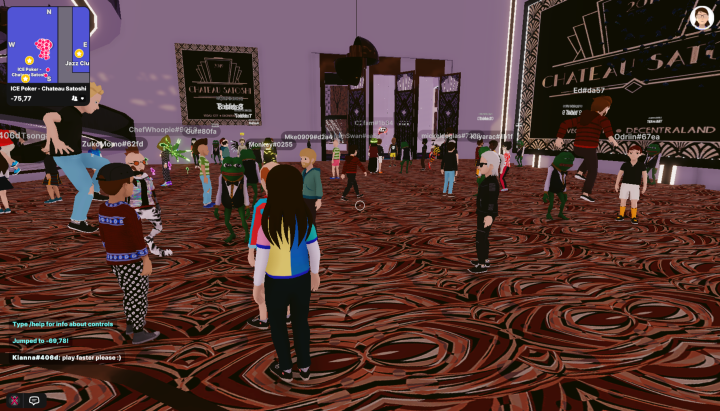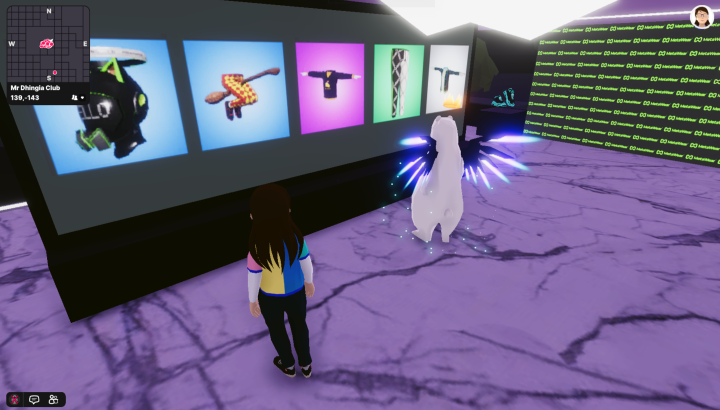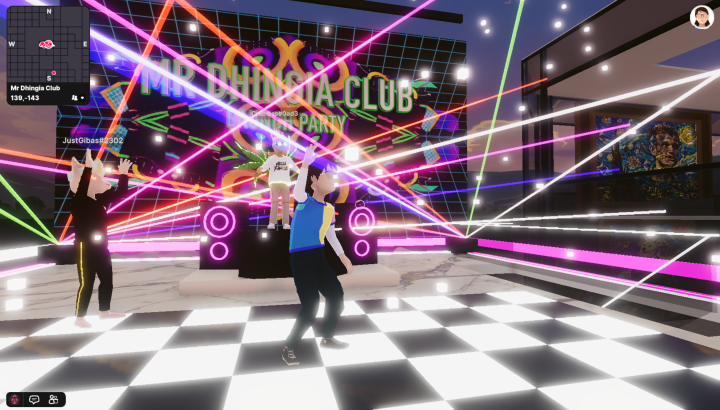A few Saturdays ago, I went to a nightclub. I dressed a bit on the casual side, donning a multicolored sweater, jeans, and sneakers. When I arrived, it was nighttime and the sky was purple, dotted with stars and wisps of cloud. I heard the booming music before I entered and there was no line at the door. It seemed fairly standard and strangely reminiscent of careless pre-COVID times, but I wasn’t going to a club in the real world — I was going clubbing in the metaverse.
The nightlife industry is expanding into the metaverse, with clubs, music festivals, and parties popping up in various virtual platforms. More venues, businesses, and organizers are exploring this trend, which is partly a COVID-fueled fad but also part of a broader move toward digital platforms that the nightlife industry has been facing since before the pandemic.
My first stop was Decentraland, one of the largest and busiest virtual spaces in the metaverse. If I was going to find a party, it would almost certainly be here. But getting in wasn’t so straightforward. After logging in, my browser screen would turn black and unresponsive, and the space took a long time to load. I switched browsers a few times to no effect, then restarted my computer. Despite what people say about the egalitarianism of these online spaces, if someone with a relatively new MacBook Pro couldn’t log in, it seems that Decentraland, at least, caters to people with advanced computers and tech — not someone idly wandering in, hoping to take a look around.

Once I got in, my first stop was Amnesia Ibiza, the metaverse iteration of a club in Spain. According to Google, the club was temporarily closed, but in the
A brave new world
Nightlife is experimenting with the metaverse for several reasons. Its foray into digital platforms was amplified by the pandemic, said Mirik Milan, the former night mayor of Amsterdam and co-founder of VibeLab, a nightlife consultancy agency. Yet even before COVID-19, there was an interest, particularly through musicians who wanted to reclaim ownership over their work through NFTs and use the blockchain to sell directly to listeners, bypassing corporate record labels.
When the pandemic began, performers and venues under lockdown began looking for other avenues to interact with fans and make money. Performers began live streaming on platforms like Twitch, hosting virtual parties, and crowdfunding to stay afloat. Travis Scott held a concert inside the video game Fortnite. VibeLab created United We Stream, a live streaming platform to fundraise and create streaming opportunities for artists in 115 cities worldwide.
Expanding into the metaverse is the latest wave of this exploration. Amnesia launched its club in Decentraland in June 2021. Bootsy Bellows, a club in West Hollywood owned by David Arquette, is entering the
“There’s definitely a huge appetite for using the metaverse or digital technologies for discovering and promoting new talent,” said Milan.
Finding the hotspots
After my less-than-stellar introduction to the metaverse at Amnesia, I was keen to find a more happening spot, and much to my surprise, it wasn’t easy. I stopped into a casino with Pepe the Frog avatars walking around, a vacant jazz club, and another eerily empty club venue complete with an NFT art gallery. So far, my mission was unsuccessful. Going in, I thought Decentraland would be a vibrant, weird, exciting space with lots of activity, but it was mostly just dead.

Thankfully, that changed when I stumbled across an event called “Mr. Dhinga Launch Party” — a club opening where creators were giving away wearable items. This, finally, was what I was looking for: The denizens of the metaverse had turned out for this party in full force, reveling in all the weird and wonderful ways you’d expect to see at a virtual party. I made my way to the rooftop, where a crowd of avatars danced around a glowing orb. I joined in and started doing some dance moves (my avatar’s repertoire consisted of dabbing and the stanky leg) next to a wolf wearing a tracksuit.
After exhausting my rather limited library of dance moves, I joined the Twitch stream of a fellow partygoer named Jacob Acebedo. His stream complemented the event and gave attendees a place to communicate with each other more easily. I found them to be goofy and nerdy, but also warm and welcoming. They talked about how the event was better than a real party and scrolled through each other’s Instagrams, complimenting their photos. One partygoer gifted me some wearable items and I returned to the event, ready to resume dancing with a new yellow tracksuit and lollipop.

A few days later, I spoke with Acebedo here in the real world. Outside of the metaverse, Acebedo is a 26-year-old military veteran and graphic design student from Southern California.
“I myself have a little bit of anxiety,” he said. “I don’t really know where it stems from — apparently it comes from the military … In real-world situations when I’m around a big group of people, my anxiety flares up. So when I’m in the metaverse, it gives me an opportunity to be around hundreds, if not thousands of people at once and not feel that overwhelming sensation I would normally feel in real life.”
But many new metaverse arrivals will have to confront the technological barriers that I did before feeling completely at ease.
“For people [who] spend a lot of time online and do online gaming, it would be much easier to have this transition into the metaverse,” said Milan. “I’m personally not a gamer myself, so for me, it will take a bit more time.”
All dressed up with nowhere to go
A few days later, I dove into the metaverse once again and attended yet another event. This one was called Le Phoque Off: An alternative music festival that, due to COVID-19 restrictions in Quebec, took place in the NOWHERE
Once inside, I wandered my way to the Sirius XM Stage, where a psychedelic rock band called Hippie Hourrah played, surrounded by a Martian landscape. Concertgoers showed their enthusiasm by spinning, blasting off, or releasing a spray of hearts. Unlike the Decentraland metaverse, which felt like an exclusive club for diehard crypto enthusiasts, I felt more comfortable in NOWHERE. It was fun to hear the music, and I liked observing the other people watching the performance from their pods and interacting with each other. It was much more accessible and I could see the artistic potential for the space.

Before going to the festival, I met up with NOWHERE’S CEO, Jon Morris, for an interview in the metaverse. He had created NOWHERE after his work was disrupted at the start of the pandemic. This
“You’re in this room with 100 people and you can hear them responding,” he said. “You can see them either throwing heart emojis or jumping and spinning and have that reciprocity, which is really cool.”
Morris, who now lives in Brooklyn, grew up in rural Kentucky with little access to those types of cultural experiences. He says this could make a difference for kids growing up in those environments today.
“That’s the whole reason we built NOWHERE,” he said. “My whole life, I’ve created experiences that deepen and excite human connection.”
Settling cyberspace
Within my explorations, there were two different manifestations of nightlife in the metaverse. One catered to people interested in being pioneers in the space, who wanted to socialize, discuss and learn more about their shared interests, which revolve largely around cryptocurrency, NFTs, and
People working in this space agree that the metaverse is in its early stages, with many technological and social difficulties that need to be worked out. And while the
“It should not be seen as a replacement,” said Milan. “If you expect the same experience as going to a club, that will never happen.”
Then again, that’s not really the point.
Editors' Recommendations
- Microsoft has a warning about working in the metaverse
- You won’t be taking Microsoft’s HoloLens 3 into the metaverse
- The metaverse is ‘off limits’ for Apple’s upcoming VR headset
- Meta believes VR haptic gloves could unlock the future of the metaverse
- Spatial is what would happen if Slack and Zoom had a virtual reality baby



